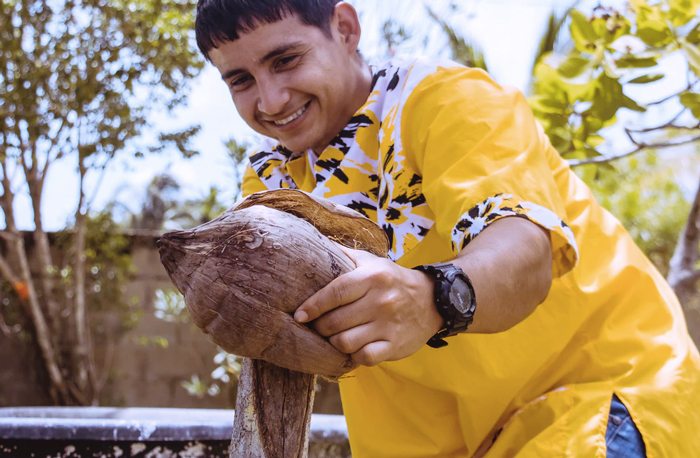More prosperous, resilient and inclusive agriculture focus of new study on the Caribbean
 Man holding a coconut in Belize
Man holding a coconut in BelizeCaribbean countries have been looking to reinvigorate their agriculture sectors, making them more competitive, more prosperous, more climate resilient and more inclusive.
FAO and the Caribbean Development Bank (CDB) recently unveiled their new study on the state of agriculture in the Caribbean.
The study was conducted prior to the global COVID-19 pandemic, which is claiming lives and livelihoods and creating much uncertainty and socio-economic hardship across the globe.
For CDB’s borrowing member countries, largely dependent on trade and tourism, the crisis could threaten food security and nutrition, reinforcing even more the need for better investments in the agriculture sector.
In addition to identifying key agricultural trends in the Bank’s borrowing member countries, the study points to investment opportunities that can improve agricultural productivity, promote inclusive economic growth and ensure sustainability – all essential for building people’s resilience to crises and shocks.
Many of the region’s countries are small island nations vulnerable to the impact of climate change and natural hazards – from hurricanes and tropical storms to drought and erosion.
Unemployment is high, and poverty and food insecurity are persistent. Most rely heavily on imported foods, and non-communicable diseases, like diabetes and obesity, are on the rise.
Countries in the region are looking to diversify their agriculture as they move away from classic exports, like bananas and sugar, said Roble Sabrie, an FAO economist and one of the study team members.
“High-value crops like fruits and vegetables, for example, are more profitable for small-scale growers. They create attractive job opportunities, especially for young people, through the use of new technologies like greenhouses or hydroponics. They also generate higher incomes, promote healthier, more nutritious diets and have excellent export potential,” he said.
Increasing productivity in agriculture, fisheries and livestock requires the use of modern technologies – including digital technologies – improved pre- and post-harvest handling practices, finance and knowledge.
“There are many niche markets waiting to be tapped,” Roble added. “Technical assistance covering everything from market research to quality and safety certification to packaging could help small-scale producers meet the requirements of these markets and also growing demand for shorter supply chains, including for the tourism industry.”
As a companion piece, FAO and the CDB published an annex featuring additional research on seven cross-cutting issues related to agricultural development, namely: climate change adaptation; infrastructure and irrigation; gender equality and youth empowerment; fisheries and aquaculture; fruits and vegetables value chains; livestock; and nutrition.
The findings from the study and annexes will contribute to the CDB’s revised Agricultural Policy and Strategy Paper.
One big area for joint work and investment in the coming years is on climate-smart agriculture, said Luther St. Ville, Senior Operations Officer at the CDB.
“We need to invest in more water-efficient irrigation systems and also drainage infrastructure for low-lying countries so they can cope better with reduced rainfall or severe drought,” he said. “I see us working closely with FAO on climate-smart approaches, both adaptation and mitigation, that will help farmers improve their productivity while managing water and land resources much better.”
The study and annexes are the result of a huge collaborative effort. The FAO Investment Centre worked closely with colleagues from FAO’s Agricultural Development Economics division, Sub-regional Office for the Caribbean (SLC) and FAO’s Strategic Programme One team working on eliminating hunger, food insecurity and malnutrition.
They also involved local stakeholders, including the University of West Indies – the top academic organization in the Caribbean – and institutions such as the Organization of Eastern Caribbean States (OECS) and the Caribbean Community (CARICOM), with FAO SLC taking a leading role.
FAO’s partnership with the CDB dates back more than three decades. These latest efforts signal the two organizations’ renewed commitment to working together for a healthier, greener future –one where there is shared prosperity and greater resilience to cope with crises.
